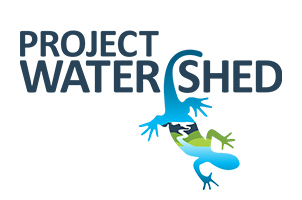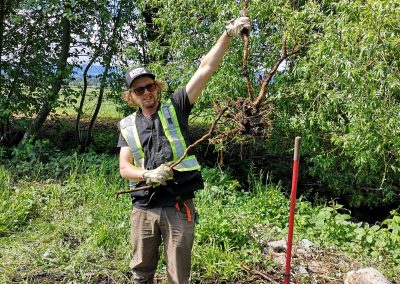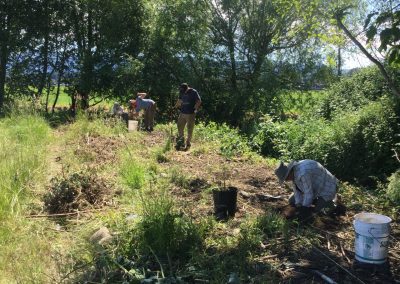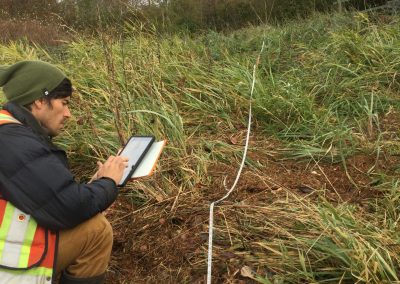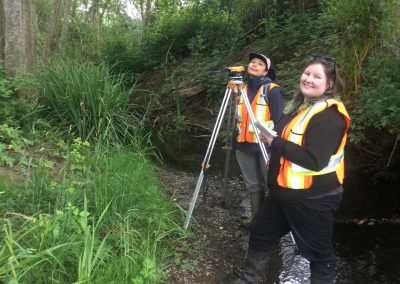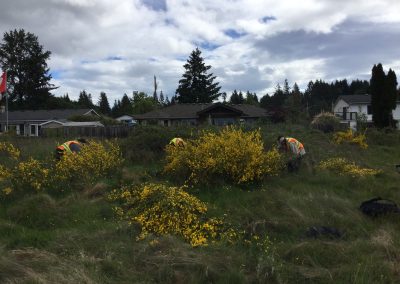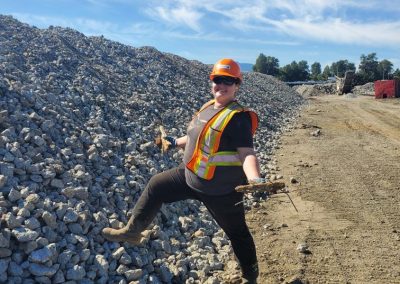Technician Report – Tuesday, December 14th
Aaron, Sam, and Zoe Removing Blackberry ~ By J. Lund
Our team removed invasive plant species from vulnerable ecosystems all season long. Scotch broom (Cytisus scoparius), Himalayan blackberry (Rubus armeniacus), Himalayan balsam (Impatiens glandulifera), bittersweet nightshade (Solanum dulcamara), and reed canary grass (Phalaris arundinacea) were the main plants targeted for removal. At Glen Urquhart stream, over 100 metres of stream bank was cleared of invasives after being surveyed. This area was then planted with native shrubs and trees such as thimbleberry (Rubus parviflorus) and red elderberry (Sambucus racemosa).
In the height of the growing season, our team surveyed six transects throughout Hollyhock Flats to create a plant species catalogue. This data will be used to track how the Hollyhock marsh changes over time, be used for modelling salt marsh restoration projects, and provide a planting guide for Kus-kus-sum. Our team surveyed 1.18 kilometres of the marsh with 234 quadrats.
At Kus-kus-sum, we were able to assist with several projects. Before concrete removal began, we cut down all the Scotch broom plants on site. This was done while they were in bloom to decrease seeds in the soil and reduce the chance of broom plant growth in the future. While concrete removal was on going, we were sorting out metal and wood for recycling. We also helped with the removal of crush from the site and installation of sediment fencing to reduce erosion.
As the seasonal Technician team winds down and heads off on new adventures, we would like to thank you for following our work with Project Watershed. We wish you all a wonderful holiday and a happy new year!
With the help of the Healthy Watersheds Initiative funding Project Watershed has hired environmental technicians to assist with our projects over the summer and early fall. The Healthy Watersheds Initiative is delivered by the Real Estate Foundation of BC and Watersheds BC, with financial support from the Province of British Columbia as part of its $10-billion COVID-19 response. Jamie Lund, one of these technicians, will be posting a brief report every Tuesday to update the Project Watershed community on what they have been up to.
Related Posts
Mallard Creek Restoration Update for 2024
Restoration work in Mallard Creek will continue this year, including invasive removal, restoring connectivity, and trial planting of a new riparian species. Volunteer events starting in September 2024.
Volunteer at Kus-kus-sum Chamber of Commerce Event
We are showing Kus-kus-sum off to businesses in the Valley through a Chamber Business to Business event. We are looking for a few volunteers to assist with this event.
Coastal Plant Monitoring
Get involved with our new vegetation community science monitoring program!
Spring Field Trips
Throughout May and June Project Watershed will be taking elementary school classes out on field trips to learn about estuary and coastal ecology and to assist with planting and plant maintenance.
Working Together to Identify Forage Fish Spawning Beaches
This year marks the 5th year of a partnership between Comox Valley Project Watershed Society and North Island College on a long-term study to examine intertidal spawning habitats of forage fish in the northern Salish Sea.
Glen Urquhart Update – Spring 2024
Latest news from Glen Urquhart restoration progress for spring 2024.

